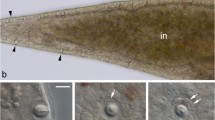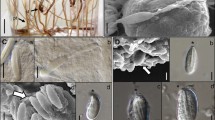Abstract
The nudibranch gastropod Cratena peregrina (Opisthobranchia: Aeolidaceae), when feeding on polyps of the hydrozoan Eudendrium racemosum (Cnidaria: Anthoathecata), devours masses of small microbasic eurytele and holotrichous isorhiza nematocysts. Large proportions of these nematocysts were found undischarged in the alimentary tracts of the snails. Feeding experiments in this study tracked the fate of nematocysts as they passed through the alimentary canal to the digestive gland in the dorsal appendages, the cerata, to the cnidosacs, and finally in the faeces. In digestive cells, many structurally intact nematocysts were present in large phagosomes that remained unaffected even after 2 days fasting, and phagosomes containing nematocysts were found in the faeces. Thus, it is inferred that fusion of nematocyst-containing phagosomes with lysosomes and subsequent digestion of nematocysts is blocked. Masses of exposed, undigested and structurally intact nematocysts were discarded in the faeces. In the tips of the cerata, other nematocysts were phagocytosed by cnidophages and stored in the cnidosacs. After release, in contact with seawater, cnidosac nematocysts were able to discharge. When cnidophore tentacles of E. racemosum with only holotrichous isorhizas were fed to the snails, the isorhizas arrived in the cnidosacs about 2 h after feeding and mixed with existing small euryteles. Some cnidosacs also contained very large microbasic eurytele or large macrobasic eurytele nematocysts, possibly from Eudendrium ramosum and Eudendrium glomeratum, respectively. This indicates that the various types of nematocysts from food were all incorporated into the cnidosacs. Evidence for a selection process or digestion of a certain nematocyst type in the cnidophages was not obtained. It is concluded that a large proportion of the nematocysts ingested with the food are not digested, but are eliminated, structurally and functionally intact, via the alimentary canal and the tips of the cerata.







Similar content being viewed by others
References
Conklin EJ, Mariscal RN (1977) Feeding behavior, ceras structure, and nematocyst storage in the aeolid nudibranch, Spurilla neapolitana (Mollusca). Bull Mar Sci 27:658–667
Day RM, Harris LG (1978) Selection and turnover of coelenterate nematocysts in some aeolid nudibranchs. Veliger 21:104–109
Edmunds M (1966) Protective mechanisms in the Eolidacea (Mollusca: Nudibranchia). J Linn Soc Zool 47:27–71
Ericsson JLE, Trump BF (1965) Observations on the application of electron microscopy of the lead phosphate technique for the demonstration of acid phosphatase. Histochemistry 4:470–487
Glaser OC (1910) The nematocysts of eolids. J Exp Zool 9:117–142
Graham A (1938) The structure and function of the alimentary canal of aeolid molluscs, with a special discussion on their nematocysts. Trans R Soc Edinb 59:267–307
Greenwood PG, Mariscal RN (1984a) Immature nematocyst incorporation by the aeolid nudibranch Spurilla neapolitana. Mar Biol 80:35–38
Greenwood PG, Mariscal RN (1984b) The utilization of cnidarian nematocysts by aeolid nudibranchs: nematocyst maintenance and release in Spurilla. Tissue Cell 16:719–730
Griebel R (1993) Fine structure of the three cell types found in the digestive gland of Elysia viridis (Opisthobranchia: Sacoglossa). Veliger 36:107–114
Grosvenor GH (1903) On the nematocysts of aeolids. Proc R Soc London 72:462–486
Harris LG (1973) Nudibranch associations. In: Cheng TC (ed) Current topics in comparative pathobiology, vol II. Academic, New York, pp 213–315
Herdman WA (1890) Some experiments on feeding fishes with nudibranchs. Nature 42:201–203
Hörstadius S (1933) Einige Untersuchungen über die Eiweißverdauung bei Gastropoden. Biol Zentralbl 53:645–650
Kepner WA (1943) The manipulation of the nematocysts of Pennaria tiarella by Aeolis pilata. J Morphol 73:297–311
Kress A, Schmekel L, Nott JA (1994) Ultrastructure of the digestive gland in the opisthobranch mollusk, Runcina. Veliger 37:358–373
Kühnel MP, Goethe R, Habermann A, Müller E, Rohde M, Griffiths G, Valentin-Weigand P (2001) Characterization of the intracellular survival of Mycobacterium avium ssp. paratuberculosis: phagosomal pH and fusogenicity in J774 macrophages compared with other mycobacteria. Cell Microbiol 3:551–566
Martin R, Walther P (2002a) Effects of discharging nematocysts when an eolid nudibranch feeds on a hydroid. J Mar Biol Assoc UK 82:455–462
Martin R, Walther P (2002b) Protective mechanisms against the action of nematocysts in the epidermis of Cratena peregrina and Flabellina affinis (Gastropoda, Nudibranchia). Zoomorphology 122:25–35
Miller JA, Byrne M (2000) Ceratal autotomy and regeneration in the aeolid nudibranch Phidiana crassicornis and the role of predators. Invertebr Biol 119:167–176
Moreteau JC (1977) Étude sur l'alimentation d'Aeolidia papillosa L. Cah Biol Mar 18:369–383
Naville A (1926) Notes sur les Éolidiens. Un Éolidien d'eau saumâtre. Zooxanthelles et homochromie. Rev Suisse Zool 33:251–286
Östman C (1997) Abundance, feeding behavior and nematocysts of scyphopolyps (Cnidaria) and nematocysts in their predator, the nudibranch Coryphella verrucosa (Mollusca). Hydrobiologia 355:21–28
Rosin R (1970) On Aeolidoidea, Coelenterata and nematocysts. Argamon, Israel J Malacol 1:43–50
Salvini-Plawen L von (1972) Cnidaria as food sources for marine invertebrates. Cah Biol Mar 13:385–400
Schmekel L, Portmann A (1982) Opisthobranchia des Mittelmeeres. Nudibranchia und Saccoglossa. Springer, Berlin Heidelberg New York
Schmekel L, Wechsler W (1968a) Feinstruktur der Mitteldarmdrüse (Leber) von Trinchesia granosa (Gastropoda, Opisthobranchia). Z Zellforsch Mikrosk Anat 84:238–268
Schmekel L, Wechsler W (1968b) Beobachtungen zur Nahrungsaufnahme und -verarbeitung in der Mitteldarmdrüse von Nudibranchiern (Gastropoda, Opisthobranchia). Anat Anz 121[Suppl]:535–543
Schuchert P (2003) Cnidaria, Klasse Hydrozoa. In: Hofrichter R (ed) Das Mittelmeer, vol 2. Spektrum, Heidelberg
Streble H (1967) Bau und Bedeutung der Nesselsäcke von Aeolidia papillosa L., der breitwarzigen Fadenschnecke (Gastropoda: Opisthobranchia). Zool Anz 180:356–372
Tardy J (1964) Comportment prédateur de Eolidiella alderi (mollusque: nudibranche). CR Acad Sci Ser III Sci Vie 258:2190–2192
Taylor DL (1968) Chloroplasts as symbiotic organelles in the digestive gland of Elysia viridis (Gastropoda: Opisthobranchia). J Mar Biol Assoc UK 48:1–15
Thompson TE, Bennett I (1969) Physalia nematocysts: utilized by molluscs for defense. Science 166:1532–1533
Trench RK (1969) Chloroplasts as functional endosymbionts in the mollusc Tridachia crispata (Bergh) (Opisthobranchia, Sacoglossa). Nature 222:1071–1072
Wolter H (1967) Beiträge zur Biologie, Histologie und Sinnesphysiologie (insbesondere der Chemorezeption) einiger Nudibranchier (Mollusca, Opisthobranchia) der Nordsee. Z Morphol Oekol Tiere 60:275–337
Wright TS (1863) On the cnidae or thread cells of the Eolidae. Proc R Soc Edinb, sessions 1858–1859, 1859–1860, 1860–1861
Acknowledgements
Support by the Deutsche Forschungsgemeinschaft (Ma 259/16-3) is gratefully acknowledged. I would like to thank P. Walther for hospitality in the laboratory at Ulm and help with high pressure freezing, E. Koenig (University at Buffalo) for revision of the text, two anonymous and a non-anonymous colleague for criticisms of the manuscript, and M. Hagedorn (Ulm) for help with the computer work. C. Valentin and his staff provided excellent working conditions at the field station at Giglio. The experiments comply with the current laws of Italy and Germany.
Author information
Authors and Affiliations
Corresponding author
Additional information
Communicated by O. Kinne, Oldendorf/Luhe
Rights and permissions
About this article
Cite this article
Martin, R. Management of nematocysts in the alimentary tract and in cnidosacs of the aeolid nudibranch gastropod Cratena peregrina . Marine Biology 143, 533–541 (2003). https://doi.org/10.1007/s00227-003-1078-8
Received:
Accepted:
Published:
Issue Date:
DOI: https://doi.org/10.1007/s00227-003-1078-8




